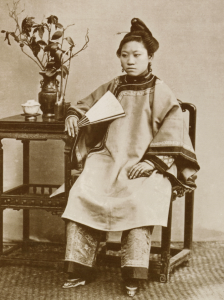



Moving forward with the topic of foot binding, we shift our focus to semiotics to dig deeper into the subject. Through a semiotic analysis, we can use our analytical skills to further understand foot binding on another level. This image is from the 2011 movie, Snow Flower and The Secret Fan, written by Lisa See. The movie was set in nineteenth century China and it focused on how women are victims of problems like foot binding.
According to See, she wants her fans “to imagine how a few such women might have found voices of their own within, rather than in opposition to, the Confucian social order, and how they found ways to self-fulfillment without flouting their culture’s fundamental values.” (Lisa See, introductory note, Snow Flower and the Secret Fan. New York: Random House (2005) p 18) .
This image accurately demonstrates the control that men have over women.
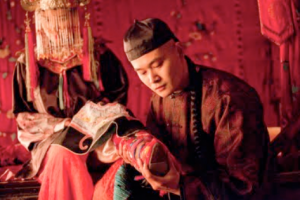
In this image clip from the film, there is a man and a woman. The woman’s face is hidden in intricate headwear. Her foot, however, is the focal point of the image and is in the man’s hand. The foot is also is dramatically adorned, further cementing it’s importance. The environment of this image is primarily red. Both the man and the woman are wearing traditional outfits. All of this is taking place in a bedroom.
The atmosphere of this photo is intimate and sexual between the man and the woman. When looking at this image, the female’s face is hidden, demonstrating its unimportance.The identity is insignificant compared to the success of the individual’s foot binding practice. In addition, the man gazing at the foot shows the cultural norm of the feet being sexualized.
This image represents control that men have over women on a greater scale. Seeing women as objects, and focusing on the ‘beauty’ of their body parts emphasizes this control. Women are mutilating their body to become what men want.
This image shows the control that men had over women in nineteenth century China. The ‘attractive’ women is one who has a small, delicate feet, that is only achieved through the torture and mutilation of oneself. Foot binding is a cultural expectation that women feel obligated to oblige by in order to have a future with a man.
We can connect foot binding to traditions such as the wearing of corsets, which were worn in order to maintain and show off an hour glass figure for men. Or the idea of the lighter the skin the more wealthy it proved someone to be. If you were tanner, it meant you were working in the fields.
Each of these traditions are somehow implemented into society’s expectations and are difficult to remove.
-Kelsey Mullaney
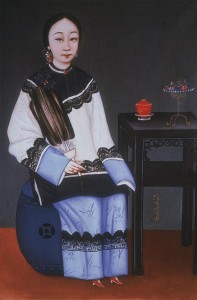
“Chinese woman with bound feet”, painting on glass, 19th century. Taken from Artstor, original source University of California San Diego.
This nineteenth century painting depicts a Chinese woman with bound feet sitting on a small piece of furniture in a minimally decorated room. Records indicate that the painting was found in China, however the nationality of the artist and the subject of the painting are unknown. Since westerners were already frequenting China and had already been exposed to footbinding it is possible that this painting is a western interpretation of the practice which, as Dorothy Ko explains in her article on western views of footbinging, could certainly influence the messages inherent in the painting (1). Although the room surrounding the woman is minimally decorated and somber, the ornate silk clothing with delicate embroidery, fine jewelry and fan in the woman’s hand as well as the ornamentation on the delicately carved side table suggests that the subject of the painting is of relatively high class in Chinese society. The position and relative size of the woman’s shoes indicate the importance of concealment inherent in the practice of footbinding and suggest that the concealment of the feet is the primary purpose of the ritual. sound claim
The colors of this painting are intentionally matched to convey the notion of concealment of the feet. The backdrop of the painting is black which is carried through the woman’s hair, as well as the side table, and the embroidery on the woman’s clothing. This backdrop gives the painting a somber mood. The white section of the woman’s clothing as well as her pale face stands in stark contrast to the black background drawing attention to the upper half of the body. The blue present in both woman’s pants and coat sleeves provides a contrast to the black and white upper half of the woman’s body but blends slightly into the blue chair which de-emphasizes the woman’s lower half. The wide pant legs not only make the feet appear extremely small but also diminish their importance relative to the rest of the woman’s body. Moreover, the shoes seem to blend into the red floor making them even less noticeable particularly relative to the white that stands in stark contrast to the black background in the upper half of the painting. The difference between the shoe color and the pant leg color also suggest that the shoes are not part of the woman’s body, almost as though they are small objects, not belonging to the woman but rather symbols representing an ideal of femininity. This matches Dorothy Ko’s explanation of the body being viewed as a part of the cosmos and not as parts belonging to an individual(2).
The relative size of the shoes particularly to the pant leg size not only emphasizes the importance of concealment in the practice of footbinding, it also emphasizes the idealized nature of bound feet. By using illusions to further reduce the size of the feet beyond the actual practice of footbinding the artist suggests that the central purpose of the ritual is to present a certain vision of femininity to the outside world, one wherein the feet themselves are concealed and replaced with an image of small well decorated parcels. why concealment?
In these ways the painting uses contrasting and blending colors as well as relative sizes to define an idealized notion of what it means to be a Chinese woman in the 19th century and central to this notion is the concealment of bound feet.
-Sophie B.
Bibliography
(1)Dorothy Ko (1997) Bondage in Time: Footbinding and Fashion Theory, Fashion Theory, 1:1, 3-27
(2)Dorothy Ko (1997) The Body as Attire: The shifting Meanings of Footbinding in Seventeenth Century China, Journal of Women’s History, 8:4, 8-27.
Chinese footbinding has existed for upwards of a thousand years. Since its inception among the upperclass and nobility, it gradually spread to working class Chinese as well. The process of footbinding involves the breaking of multiple bones in the foot and wrapping of the injured area and lower leg. This painful process leaves the woman in a state of discomfort for years and subsequently, makes walking and independent movement very difficult, if not impossible. Because of this, it was a sacrifice to the family of working class women to bind the feet of their daughters who would not longer be able to provide labor the family might desperately need.
may start from here: In the four images in this post, we see two very distinct types of golden lotus shoe. The first two, are what we might expect. They are small, dainty, and beautiful, while the other two are utilitarian and bulky. In comparing these images, I will explain how the reality versus the dream of footbinding affected working class women so much.
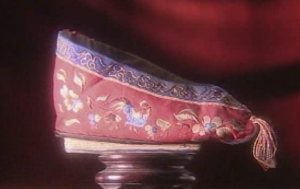
Source: Chinese Footbinding: The Vanishing Lotus. 2004
These golden lotus shoes are intricate and delicate. We see that they are carefully hand embroidered with many important symbols. In the red shoe with a tassel, there is a delicately stitched rooster. This indicates a good marriage between the wearer and her husband. The tassel further indicates the plush and dainty lifestyle of the wearer. She is an ornament. The purple shoe shows embroidered flowers which one can interpret as the sign for wealth and success. These shoes would have been worn by a young unmarried woman.

Source: Chinese Footbinding: The Vanishing Lotus. 2004
These shoes are incredibly delicate, and meant to be worn by women who would not often walk around outdoors. One can see this because of how intricate the embroidery of the silk is. Wearing these shoes outdoors in the elements would be a waste of them, they’d be ruined.
In contrast, these next two images show shoes that are much more practical for outdoor use. Both the shoes in these images are made of leather, a durable material, more appropriate to outdoor use. In the first of these shoes, we see small crafted spikes on the bottom of the shoe. The stitching and base of the shoe all indicate something created for wear and tear, or at the very least, repeated use. The shaft of the shoe goes up higher than other golden lotus slippers, possibly indicating that it is meant to protect the wearer from snow or rain, various other elements.
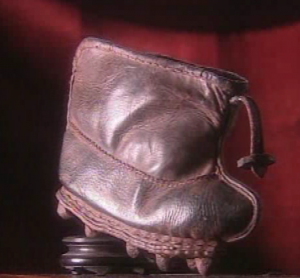
Source: Chinese Footbinding: The Vanishing Lotus. 2004
The second pair is even more utilitarian than the first. It is also made of leather, and is meant for stability as indicated by the flat sole and sturdy front flaps with eyelets for laces. These are neutral in color, black, and meant to be worn everyday.
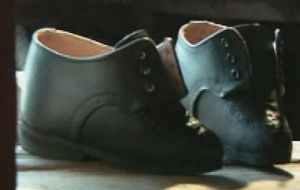
Source: Chinese Footbinding: The Vanishing Lotus. 2004
The difference in these shoes shows the difference in the lives of rich and poor footbound women. Rich women could afford to wear the delicate embroidered silk shoes, and lounge about their home. Poor women still had to work however, and as such wore more utilitarian, practical shoes. While footbinding was the ideal of beauty for more than a thousand years, its appeal was much more for the dainty embroidered shoes. The reality of footbinding for women of a working class was not the beautiful shoes we’re accustomed to seeing in context of footbinding, but rather these plain, utilitarian shoes.
detailed comparison. the difference could mean different materials in different time
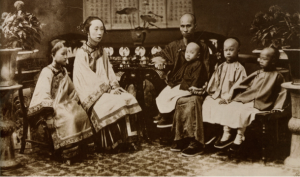
The exact origins of foot binding in China can not be explained by one event or one reason. In actuality there are many theories of how and when foot binding in China took place, why it continued for so long and what in meant in a social, cultural, political, national and familial context. It is known that foot binding came into practice during the Song Dynasty (960-1279), and foot binding remained the popular fashion in China until the early 1900’s. Foot binding survived in China for hundreds of years and it has stood as a symbol for many different purposes. For example in the seventeenth century foot binding was used to demonstrate Han Chinese civility. A bound foot also has represented beauty, femininity, social status, political loyalty, female oppression and female liberation. Foot binding can not be reduced to one story or one meaning because it has served for so many different purposes over a vast length of time. However I want to focus on the relationship between foot binding and the family. may start from this statement, due to word limit
Foot binding in China, among many things, represented femininity and beauty in concealment. In order to get married a woman must have had her feet bound, in fact small feet were often more important then a pretty face. A woman with her feet bound had to take small steps and she couldn’t travel very fall. This gave off the illusion of a delicate nature and also led to female dependence on male counterparts. Concealment, delicate femininity and a submissive nature became desired traits a woman sought after in her home life and were subsequently passed down from mother to daughter through the process of foot binding. stay with your statement: foot binding and family
This photo was taken by a professional photographer and is of a Chinese family. In this photo the girls and boys are clearly separated, which expresses the divide of power among men and women in the home. The man, presumably the husband, has his arm at rest and is staring directly into the camera. The sons are also staring straight into the camera, while the wife and daughter are staring off into the distance. This demonstrates that a woman is valued by her subtlety and reservedness.
Foot binding was a tradition that was passed on from mother to daughter, (topical claim) so although it was practiced throughout China, it was also a personal and familial matter. In this photo the mother and daughter are seated next to each other and are both dressed and and positioned almost exactly the same way. This portrays how mother and daughter relationships advanced traditions. The women’s feet are predominantly concealed, with just the tip of the lotus shoe revealed, demonstrating the idea of beauty in concealment. The woman are sitting up straight while the men are allowed to slouch. The women’s clothing is silk, ornate and well preserved. Their hair is well kept and decorated. The women in this photo appear well-mannered, civilized, polished and decorated, while the men seem more relaxed, they are less decorated and there feet are not bound. Although bound feet did emphasize the importance of a delicate and submissive women, it also put the power of conserving Chinese civility in the hands (or feet!) of the women, clearly demonstrated by this family portrait.
In the family, foot binding was just as complicated and multi faceted as it was in all of China. It separated the women from the men and it continued through mother-daughter relationships. While one could argue that this practice kept Chinese women weak and dependent, foot binding also put the emphasis of maintaining Chinese civility on the women of the home.
paragraph organization: 1) different between men and women; 2) relation between mother and daughter
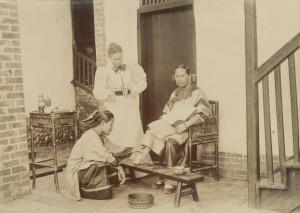
Taken by William Charles White, called “Bounded Foot (Unbound),” (1873-1960).
This photo shows a woman with her bounded foot exposed. She is being taken care of by two other women, who could be her maids. She is clearly looking straight at the camera, knowing the picture is being taken of her exposed feet. Foot binding was a practice common in China for centuries. The earliest piece of evidence found from this practice is dated from around the twelfth or thirteenth century. It was an indication of civility, grace, and ethnic superiority for Chinese women, practiced from a young age. It was a desirable trait to have one’s feet bound because it was attractive in society and elevated one’s status. Foot binding was widespread, and often had a mysterious reputation that caused fetishization. Women kept their feet bound in finely decorated shoes, and did not allow men to see the naked shapes of their feet. This was a tradition between mothers and daughters. Due to this mysterious female secret, it is assumed that this also caused erotic imagination. I believe that this was a picture taken during the later years of the foot binding practice, perhaps when it was about to end, because this woman would not have allowed this picture to be taken otherwise. Her embodiment of the image of her bound foot indicates her acceptance or compliance of revealing her feminine secret.
The history of foot binding has largely been lost, but it was a tradition that lasted many years and dynasties. European and other Western civilizations observed Chinese culture and misunderstood their fashion and traditional practices, which often lead to devaluing their societies as a whole. In fact, the practice became unpopular in China because of outside influence claiming it was “shameful.” Foreigners invaded their space in order to criticize and expose the critical part of foot binding– the concealment. Chinese women allowed the exposure of their deep secret in order to gain a pension from the curious Europeans who wanted to take pictures of the unfamiliar practice.
find a focus and make an argument
analysis could begin from here: The woman in the picture is looking straight at the camera, focused and prepared for the photograph. Only one foot is exposed, but the audience is able to see the entire bend of the bound foot. Underneath the bench is her other foot, still in its intricate shoe. She is a well-dressed woman who is clearly wealthy enough to have other women tend to her feet. Due to these signs, I believe I can assume that this was probably one of the women who was paid to show her bound foot. She may or may not have had the choice in doing so, but we may never know because this practice was only historically recorded by men. The women are outside, perhaps cleaning the exposed bound foot, which seems to be unlikely at a time when the binding was still supposed to be concealed. The photographer has a Western name, which could further indicate that a foreigner photographed this revealing scene.
In conclusion, I believe that this woman exposed her bound foot unwillingly. (make the claim at the beginning of the entry) Based on the time period of when the world saw photos of the practice and discredited the tradition, I can imagine that the foot binding practice was on its decline in prevalence in society. The photograph exposes an integral issue in Chinese history of maintaining civility, feminine elegance, and high standards of beauty for women.
how about the significance of the unknown photographer as the subject and the woman with bound feet the object of being photographed?
Sources:
Dorothy Ko, “Bondage in Time: Footbinding and Fashion Theory,” Fashion Theory Volume 1, Issue 1, 1997: 3-28.
Dorothy Ko. “The Body as Attire: the Shifting Meaning of Foot binding in Seventeenth-Century China.” Journal of Women’s History 8-4 (Winter 1997): 8-27.
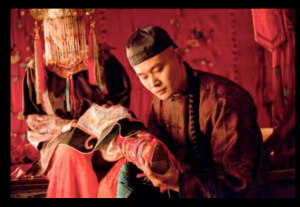
source: Snow Flower and the Secret Fan (2011)
During the Neo-Confucian ages in China, foot binding was a prevalent and deep-rooted cultural tradition. This multifaceted act of physical mutilation and ornamental embellishment was also, depending on time and perspective, dynamically symbolic of wen civility, the familial system, sexuality, femininity, character, and nationalism. This snapshot image of an intimate moment of a newly wedded husband delicately holding and examining his new wife’s bound feet in the foreground while the wife blends into the background is representative of the fetishization and disproportional importance of bound feet, the small foot as the epitome of the beauty aesthetic, and the paradox of concealment and modest exposure that contributes to sensuality. your argument?
Through a purely aesthetic lens, the viewer of the image is first struck by the obvious color scheme of the scene. With bold reds, blacks, and browns in varying shades and lighting, the color subconsciously guides our eyes and thus our focus. For instance, the two subjects of the image have wardrobes of dark color, both the female and male wearing a predominantly brown wardrobe. However, the female’s lower leg and foot are clothed in a vibrant red, contrasting with its surroundings and bringing the viewer’s attention to the bound foot, (the bound foot could be the first point of attraction) conveying that the foot is actually the true subject of the image, and subject of the man’s desires. Furthermore, the woman is on the edge of the image basically blending into the background while the man is placed in the foreground but half-cloaked in shadow. The image shows that the foot itself is of more concern and importance than the person it belongs to. Instead of the two human characters in the scene, the foot is given the complete spotlight. This emphasis that is placed on the foot through lighting and color in this context demonstrates that the bound foot transcends the visible and physical and signifies the disproportional importance of a small foot in marriage and its general importance in the lives of wives, husbands, and the Chinese.
structure of foot then color and light
the bound foot and veiled face indicate that …. Also, a veil covers the woman’s face, her body is draped in layers, and her husband’s gaze is solely focused on her lower leg and foot. This intense combination of admiration and analysis, even celestial reverence, that the husband shows for the singular foot highlights the lack of those same feelings towards his wife as a whole. Even more, upon first glance, the woman’s presence is unnoticeable, minimal at best, unlike her center-displayed foot. Ultimately, this strategic placement of the wife and the purposeful tunnel-vision of the husband portrays the ideology that the foot holds the most beauty and deserves to be admired, while the face and body of a wife is of little concern to the husband. The small foot was the only physical trait that assigned beauty value to a woman and set a beauty standard for a man.
The fetishization of the foot against the spatial setting of the wedding chamber suggests that …. Lastly, this scene seems to be set in an intimate environment with the woman sitting on a bed and many curtains and drapes around the two characters. The fetishization and focus placed on the foot provides a sexual undercurrent to the image while the setting casts a sensual and intimate light onto the subjects. Though the woman’s body is very concealed (even her face is covered), the foot peeks out of her long robe, modestly titillating the audience and husband. Thus, I would argue that the paradox of concealment and modest exposure contributes to the subdued but present sensuality expressed in this image and many romantic relationships during neo-Confucian China. Through careful examination, we observe that the symbolic image delivers many messages about the act and meaning of footbinding in China. This one image embodies the traditional importance and obsession with ‘golden lotuses’ as an extreme form of beauty and sensuality, and simultaneously offers a visual representation and therefore a more realistic understanding of footbinding from a less biased Chinese cultural perspective.
focus on one idea in one paragraph and start the paragraph with a topic sentence
In early Chinese culture, Foot Binding was a sign of beauty and elegance. Foot Binding (or Golden Lotus) is rumored to have been started by a Chinese Prince’s sexual interest in one of his concubines small feet. He was said to have watched her dance on a pedestal of golden lotus. This story is where Golden Lotus gets it’s beauty and elegance connotation. After many years of this practice being a part of Chinese culture, Golden Lotus became a sort of right of passage for young Chinese girls into becoming a woman. Women bound their feet because it had connotation of high class, luxury, and grace. Men were sexually driven by the bound foot’s concealment. However, although to Chinese culture foot binding was a beautiful practice, westerners saw it to be ugly and shameful. After being confronted about the ugliness of the practice, many Chinese families discontinued the practice. Westerners only saw the ugly denotation of foot binding, instead of looking at the beauty connotation of the practice.
start from here: The image below is of a group of Chinese women with bound feet. Although bound feet were a sign for social class, clothing was also a sign of social class. In the photo the woman sitting in the middle is wearing a very fancy dress that is probably made of high quality fabric. She also has a flower or head accessory on her head, which shows that she is of middle or high class. Comparing this woman to the woman to her right, you can see that the woman on the right has a dress that is probably of less quality fabric and is wearing pants instead of full dresses like the other women. Many times women of this dress were workers, prostitutes, or low class women. The shoes all the women are wearing however are small slippers of nice designs and patterns. In many photo of women with bound feet, they are seen sitting down. This is so that their feet can be seen because that’s how important the Golden Lotus was. The women’s dresses also are long enough to hide the small slippers, which goes back to the bound foot’s concealment aspect.
Overall, Foot Binding was a practice misinterpreted by western views. However, within Chinese culture it had a beautiful connotation that was elegance, luxury, and grace for Chinese women. Foot binding was a fashion for Chinese women.
make an critical argument first, then organize the analysis with denotation-connotation structure: dress indicates social class, for instance.
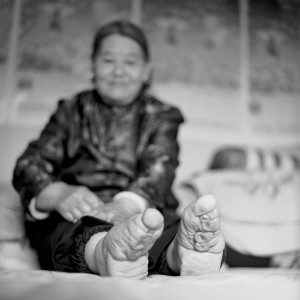
Source: Farrell, Jo: “Su Xi Rong (i),” 2014.
The image above, taken by Jo Farrell, depicts one of the last remaining women with bound feet, named Su Xi Rong. The black and white photography is clearly focused on the woman’s unbound, bare feet, while the rest of her body and face are blurred out. The image is a part of Jo Farrell’s collection, called the “Living History Project,” where she is documenting the lives of Chinese women who bound their feet and are still alive to tell their stories. She has been working on this personal project for a few years and many of the women she has photographed have died. This leads her to believe that it is imperative to celebrate and photograph the last remaining women because of their historical significance.
There are many important parts of this photograph to take into consideration regarding the construction of the image. The first is the lack of color in the photography, where Jo Farrell decided to use black and white photography. This technique is important to the composition of the photo because it is taking away any distractions that may pull the eye away from the main focus of the photo – the woman’s feet. The second important part of the construction of the photo is the focus on the bound feet, blurring out the rest of the image. These two things together create a focal point on the feet, placing an emphasis on them and their significance. By using black and white and focusing solely on the feet, the photographer has managed to show the importance of the feet and how this connects to society.
In Chinese society, bound feet were a symbol of high class, marriageability, gender, and sexuality, however, these feet were bound and concealed. When the foot was taken out of its binding, it shows the pain and deformation that women went through in order to achieve all of these things. This image strips away the fabric and binding and focuses on the foot itself. The viewer can see that many parts of the foot are deformed and broken. This significantly impacted the way the women moved and limited their mobility, representative of dependence on her family and her husband. This may be suggestive of why she is sitting down in the photograph.
The other interesting part of this photograph is the fact that the woman’s face is blurred out of the picture. This is representative of how the appearance of the woman’s feet were more significant than her true identity. The length of the feet determined her value, rather than her intellect or personality. This emphasis on outward appearance in order to impress men and find a husband ultimately stripped away many women’s identities, placing their value solely on their feet. She would hide her real body in bindings and fabric, deforming it in order to please men.
Although many women did not feel that they were forced to alter their bodies, they grew up in a society society dominated by males and were taught to bind their feet by their mothers. The seemingly simple nature of this photo is actually incorrect. Although the idea of foot binding seems like a simple act of fashion, it ultimately has many more meanings and truths behind it, that are not simply black and white or blurred out, just like the background of this photo.
a thoughtful analysis
-Marlaina
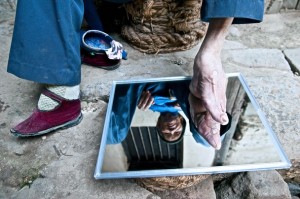
Source: Passarini, Mattia: “Last foot-binding,” 2013, Yunnan-China.
This image above, titled, “Last foot-binding” portrays an elderly Chinese woman from the Yunnan province with bound feet. One of her feet is dressed in a simple yet elegant maroon cotton lotus shoe. The left foot, however, is exposed to the photographer, unbound and bare. The unbound foot rests atop a square mirror, where the audience sees the reflection of the elderly woman’s face next to the view of the bottom of her foot. The photographer explains how, when this photograph was taken in 2013, less than 10 elderly women with binding feet were still alive in China.
The image exemplifies how perceptions of Chinese women with bound feet are limited and short-sighted. When viewing “Last foot-binding,” one can observe various signs upon conducting a deep connotative analysis of the image:
1) Age: The woman is one of the last surviving Chinese women with bound feet. Considering this, the image connotes the end of a time period and the end of a cultural phenomenon as represented through foot binding. Though this form of “fashion” may no longer be regarded as “in style,” it is important to note how the age of the woman exemplifies how this feminine fashion, bound feet, forcibly transcends time. For the woman in this image, bound feet are an unchanging part of her, coercively ageless despite changing fashion trends.
2) Contrast of the left foot to the right foot: The woman’s feet are contrasted to one another, the right foot covered while the left foot is bare, to show the permanency of the trend. In considering this contrast, one can also consider themes of secrecy and openness. Dorothy Ko in her article, “A Bondage in Time,” explains how foot binding once embodied and air of mystery. The image acts to uncover the mystery, while still hinting towards the enigmatic nature of the trend.
3) Clothing: The style of clothing that the elderly women wears is comfortable, casual, and worn down. Ko explains how the meaning of foot binding changed throughout history as it was embodied by different socio-economic classes. The audience can consider the woman’s life, as image suggests that the woman did not live a life of leisure, but a possibly laborious life.
4) The mirror: The focal point of this image is the bare, exposed bound left foot. It is interesting, however, that Passerini would use a mirror to reflect the elderly woman’s face slightly to the left of the focal point. The reflection of the woman’s face causes the audience to consider the woman as a separate entity from the bound foot. Her face is one piece of the image, while her feet are a separate part of the image, unattached to one another, yet still connected. The image acts to alter one’s perception of foot binding and perception of Chinese women as being defined physically, mentally and spiritually by foot binding.
The image ultimately causes the audience to reflect on their own conceptions, knowledge, and even apprehensions toward foot binding by adding a personal and human element to the image.
-Sarah persuasive analysis. the photographic design/manipulation could be further addressed